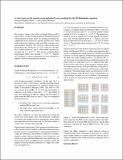A short note on the nested-sweep polarized traces method for the 2D Helmholtz equation
Author(s)
Zepeda Nunez, Leonardo Andres; Demanet, Laurent
Downloadnote-nested-polarized.pdf (2.904Mb)
OPEN_ACCESS_POLICY
Open Access Policy
Creative Commons Attribution-Noncommercial-Share Alike
Terms of use
Metadata
Show full item recordAbstract
We present a variant of the solver in Zepeda-Núñez and Demanet (2014), for the 2D high-frequency Helmholtz equation in heterogeneous acoustic media. By changing the domain decomposition from a layered to a grid-like partition, this variant yields improved asymptotic online and offline runtimes and a lower memory footprint. The solver has online parallel complexity that scales sublinearly as θ(N/P), where N is the number of volume unknowns, and P is the number of processors, provided that P = θ(N[superscript 1/5]). The variant in Zepeda-Núñez and Demanet (2014) only afforded P = θ(N[superscript 1/5]). Algorithmic scalability is a prime requirement for wave simulation in regimes of interest for geophysical imaging. Keywords: frequency-domain, finite difference, modeling, wave equation, numerical
Date issued
2015Department
Massachusetts Institute of Technology. Department of MathematicsJournal
SEG Technical Program Expanded Abstracts 2015
Publisher
Society of Exploration Geophysicists
Citation
Zepeda-Núñez, Leonardo, and Laurent Demanet. "A Short Note on the Nested-Sweep Polarized Traces Method for the 2D Helmholtz Equation." SEG Technical Program Expanded Abstracts, 2015, pp. 3682–87.
Version: Author's final manuscript
ISSN
1949-4645